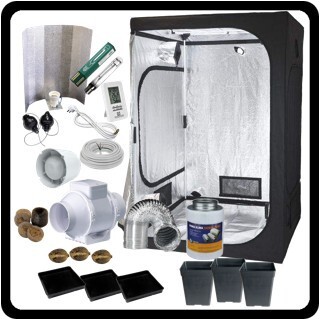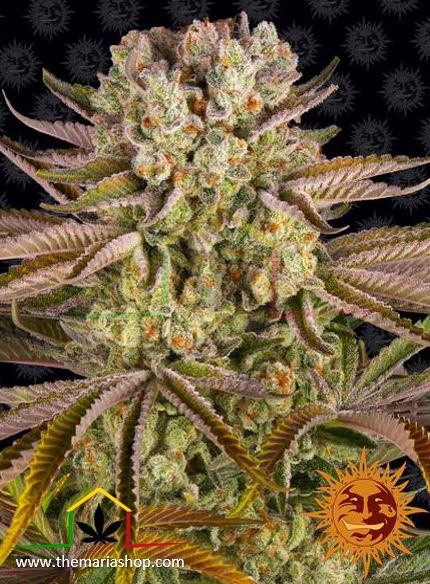
How to create a cannabis grow room or grow tents
How to set up a cannabis grow room
If you’re thinking about growing indoors without a grow tent, whether you want to build it yourself or set up a grow room directly in a room, this guide is for you. In our online grow shop, we explain everything in detail.
Choosing the surface you want to use for cultivation
To start building our own homemade grow room, the first step is to choose or select the surface we want to use. That is, depending on the number of plants we want to grow, we will need more or less space. Once we know how many plants we want to cultivate, we can begin constructing the structure of the grow tent or room.
Let’s imagine we want to grow 20 plants but have a room of 10m². The ideal approach is to build a structure that reduces the usable surface. This way, we can make better use of the light from the lamps, and it will be easier to maintain the necessary temperature and humidity for cultivation.
How to calculate the number of plants you can place in a grow room?
When we want to calculate the number of plants we can grow in a marijuana grow room, we need to consider two things. First, whether we’ll be growing from seeds or clones, and second, the size of the pots we’ll use.
If growing from seeds, we recommend using 11-liter pots. In this case, the ideal is to grow up to 7 plants per square meter.
If growing from clones, we recommend using 7-liter pots. This allows us to grow up to 14 plants per square meter.
For example, if we have a 10-square-meter room and want to grow seeds in 11-liter pots, the calculation would be:
7 plants × 10 m² = 70 plants. This is an approximate calculation; remember that we need to leave space to access all the plants easily for watering and maintenance.
Now, if we’re growing clones in 7-liter pots, the calculation would be:
14 plants × 10 m² = 140 clones. This would be the approximate number of plants we could fit in the room.
Building a structure for a homemade grow tent
Once we’ve determined the number of plants we want to grow, we can proceed to build the structure. We can use wooden slats to create the frame, and for the walls, we can use drywall panels. If your budget is low and you don’t want to build a large structure, you can cover the walls with cardboard. However, you might prefer to buy a grow tent and save yourself the work.
Necessary materials for growing marijuana plants indoors:
Mylar reflective paper
Lighting system
Air extractor
Air intake fan
Aluminum duct
Activated carbon filter
Thermo-hygrometer
Light timer
Humidifier or dehumidifier
Pots
Drip trays or saucers
Marijuana seeds
Soil
Fertilizers
Buying materials for indoor cultivation
Once we have the structure built or the grow room cleaned and disinfected, we need to buy the cultivation materials we require. But before purchasing, we need to know how to calculate the required power for the lighting system and the air extractor and intake fan.
Covering the walls with Mylar reflective paper
To improve the reflection of the light we’ll be using, we can cover the walls with Mylar reflective plastic. This will help us make better use of the light.
Lighting for indoor cultivation
Nowadays, we have several types of lighting for growing marijuana indoors. Below, we provide the different types of lighting available and how to calculate the required power.
Types of lights for cultivation
 |  |  | |
| High-pressure sodium lighting | Low-consumption CFL bulbs | LED lighting |
Currently, the most profitable and effective are LED lighting panels, but the price of these lighting systems is not within everyone’s reach, as the cost is somewhat high.
How to calculate the power of lamps?
If we are growing with conventional sodium lamps, we recommend calculating the number of lamps as follows:
| Watts | Area |
| 250w | 80 x 80 cm |
| 400w | 100 x 100 (1m2) |
| 600w | 120 x 120 cm |
So let’s suppose we have a 10m² room. To calculate the number of lamps, we perform the following operation:
400w x 10m² = 4000w.
Now we know the total wattage we’ll need. The next step is to divide this by the power of the lamps we want to use. If we want to use 600w lamps, we divide:
4000w ÷ 600w = 6.66 lamps.
Since we need to leave space for watering and other tasks, in this case we recommend installing 6 lamps.
If we want to grow using LED lighting, we follow these guidelines:
| Area | Watts |
| 60 x 60 cm | Hasta 100w |
| 80 x 80 cm | 100 – 200w |
| 100 x 100 cm | 200 – 340w |
| 120 x 120 cm | 340 – 600w |
| 150 x 150 cm o más | 600 – 1000w |
Installation of an air extractor
Now that we know how many grow lights we need, it’s time to think about the extraction system we’re going to need.
How to calculate the power of an air extractor for a grow room?
To calculate the power of the air extractor, we need to measure the size of our grow tent or room. We must multiply the height by the width by the length of the space. The result will give us the cubic meters of our grow room.
Now, to determine the required extractor power, we multiply the cubic meters by 30.
- Minimum required extraction volume = (Height x Width x Length) x 30.
Example:
Room measurements: 2 meters high x 5 meters wide x 5 meters long = 50 m³ x 30 = 1500 m³ (This is the minimum extraction power needed for a room with these characteristics). Now we can calculate the extractor power for the grow room and know exactly which one we should buy.
Installation of an air intake for the grow room
In a grow tent or room, it is important to renew the air. If we extract air with an exhaust fan, it is important to have an air intake to bring fresh air into the grow room. The power of the air intake can be equal to or lower than that of the exhaust fan, but never higher. The minimum intake power should match the extraction power.
If we need 600 m³ of extraction, we divide it by 4 = 150 m³, which is the minimum intake power required.
Ducting for air extraction
When buying an extractor, don’t forget to also get the ducting, which is essential for venting the air out of your grow space. When installing the ducting, try to avoid too many bends, as these reduce the extractor’s efficiency. If your setup requires several bends to expel the air, keep this in mind when choosing your extractor—you’ll need a bit more power. As a rule of thumb, increase the extractor’s capacity by about 30% for every bend in the ducting.
Example:
- First bend = 600 m³ × 1.3 = 780 m³
- Second bend = 780 m³ × 1.3 = 1,014 m³
Installation of an activated carbon filter
Odor is one of the most common issues in cannabis cultivation, which is why it’s important to install an activated carbon filter. This helps reduce the smells coming out of the ducting. Carbon filters are also rated in m³/h and should match or exceed the extractor’s capacity, but never be lower. For example, if you have a 600 m³/h extractor, the filter should be 620 m³/h or higher.
Measuring Temperature and Humidity with a Digital Thermo-Hygrometer
Don’t forget to buy a digital thermo-hygrometer. One of the keys to successful cultivation is maintaining the right temperature and humidity, and to know these conditions accurately, you’ll need one or more of these devices.
Installing a Light Timer
Another key aspect of cultivation is maintaining a proper light cycle. To make sure we never forget to turn the lights on or off, it’s important to get one or more light timers, depending on the number of lamps you have.
A light timer is a device with a built-in clock that allows you to program the hours you want the lights to be on or off.
Light Parameters for Indoor Cultivation:
Photoperiod Strains:
- Vegetative stage: 18 hours of light / 6 hours of darkness
- Flowering stage: 12 hours of light / 12 hours of darkness
Autoflowering Strains:
- 18 hours of light / 6 hours of darkness (throughout the entire cultivation)
- 20 hours of light / 4 hours of darkness (maximum yield)
Humidity Control in Indoor Cultivation
Once all the equipment is set up, use the thermo-hygrometer to measure the humidity in the grow room.
Remember that during the vegetative stage, you’ll need a humidity level between 50% and 70%. If it’s lower, you’ll need to use a humidifier to raise the humidity in the grow space.
If the humidity is too high, the only way to reduce it is by using a dehumidifier.
Pot Size
As mentioned earlier, our recommendation is to use 11-liter pots if you’re growing from seeds and 7-liter pots if you’re growing from cuttings. We never advise using smaller pots.
Once you have the pots, all that’s left to start your cultivation is to buy the substrate you’ll use, the fertilizers, and the cannabis seeds.
High-Quality Cannabis Seeds
It’s very important to buy high-quality cannabis seeds, such as those from Sweet Seeds, Barney’s Farm, Dutch Passion, or other reputable seed banks available in our online grow shop.

